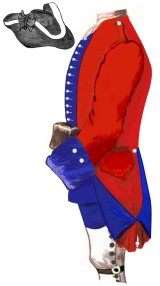41st (Welch) Regiment of Foot
The 41st (Welch) Regiment of Foot was an infantry regiment of the British Army, formed in 1719 and amalgamated into The Welch Regiment in 1881.
The regiment was raised by General Edmund Fielding in March 1719 out of independent companies of invalids and Chelsea out-pensioners - soldiers incapable of normal service through disease, age or injury. They were renamed the Royal Invalids in 1741, and in 1751, they were numbered the 41st Regiment of Foot. In 1782, when other regiments took county titles, they were denoted as the 41st (Royal Invalids) Regiment of Foot; in 1787 they ceased to comprise invalids and became a conventional line regiment, dropping the title. They finally received a territorial affiliation in 1831, becoming the 41st (Welch) Regiment of Foot.

The 41st Regiment served with distinction in Canada during the War of 1812 where it gained more battle honours than any other British unit during that period. It participated in the capture of Detroit under Major General Isaac Brock (for which he was knighted). They were involved with the siege of Fort Meigs, the battle of the River Raisin and took part on board British ships during the Battle of Lake Erie. After the defeat, the 41st retired from Fort Amherstburg (Malden) under the command of Major-General Henry Procter and were defeated at the Battle of Moraviantown, or the Thames.
Shadrack Byfield served as private in the Regiment from 1809 to 1815. He saw action with the 41st in many of the War of 1812's most important battles before losing an arm at Conjocta Creek in 1814. Byfield later chronicled his wartime experiences in his memoirs.
Patrick Cleburne, an Irish immigrant to America who rose from Private to Major General in the Confederate Army during the U.S. Civil War, was a member of the 41st Regiment from 1846–49, prior to moving to the United States.[1]
The unit is still represented today by a group of historical re-enactors from all over Ontario, including Fort George. There is another unit in Wales, the regimental home.
Battle Honours
The regiment's battle honours were as follows:[2]
- Ava
- War of 1812: Detroit, Queenston, Miami, Niagara
- 1st Afghan War: Kandahar (1842), Ghazni (1842)
- Crimean War: Alma, Inkerman, Sevastopol
Victoria Crosses
Two Victoria Crosses were awarded to men of the regiment
- Sergeant-Major Ambrose Madden, Crimean War (26 October 1854)
- Captain Hugh Rowlands, Crimean War (5 November 1854)
Colonels of the Regiment
Colonels of the regiment were: [2]
The Regiment of Invalids
- 1719–1743: Lt-Gen. Edmund Fielding
- 1743–1752: Col. Tomkyn Wardour
The 41st Regiment of Foot (Invalids)
- 1752–1764: Lt-Gen. John Parsons
- 1764–1765: Maj-Gen. Alexander Leslie, 6th Lord Lindores
- 1765–1771: Maj-Gen. John Parker
- 1771–1784: Lt-Gen. Jordan Wren
- 1784–1790: Maj-Gen. Archibald McNab
The 41st Regiment of Foot
- 1790–1808: Gen. Sir Thomas Stirling, 5th Baronet
- 1808–1809: Lt-Gen. Hay McDowall
- 1810–1819: Gen. Sir Josiah Champagné, GCH
- 1819–1837: Lt-Gen. Hon. Sir Edward Stopford, GCB
The 41st (Welsh) Regiment of Foot
- 1837–1848: Gen. Sir Ralph Darling, GCH
- 1848–1861: Gen. Charles Ashe à Court-Repington, CB, KH
- 1861–1881: Gen. Sir Richard England, GCB, KH
References
- ↑ National Park Service: Patrick Cleburne
- 1 2 "41st (the Welsh) Regiment of Foot". regiments.org. Archived from the original on 23 February 2007. Retrieved 11 July 2016.
External links
- "41st (Welsh) Regiment of Foot". regiments.org. Archived from the original on 13 January 2008.regiments.org
| Preceded by Royal Invalids |
41st (Welch) Regiment of Foot 1719–1881 |
Succeeded by The Welch Regiment |